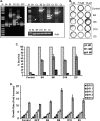Prolylcarboxypeptidase regulates proliferation, autophagy, and resistance to 4-hydroxytamoxifen-induced cytotoxicity in estrogen receptor-positive breast cancer cells
- PMID: 21087932
- PMCID: PMC3024782
- DOI: 10.1074/jbc.M110.143271
Prolylcarboxypeptidase regulates proliferation, autophagy, and resistance to 4-hydroxytamoxifen-induced cytotoxicity in estrogen receptor-positive breast cancer cells
Abstract
Endocrine therapy with tamoxifen (TAM) significantly improves outcomes for patients with estrogen receptor-positive breast cancer. However, intrinsic (de novo) or acquired resistance to TAM occurs in a significant proportion of treated patients. To identify genes involved in resistance to TAM, we introduced full-length cDNA expression library into estrogen receptor-positive MCF7 cells and exposed them to a cytotoxic dose of 4-hydroxytamoxifen (4OHTAM). Four different library inserts were isolated from surviving clones. Re-introduction of the genes individually into naive MCF7 cells made them resistant to 4OHTAM. Cells overexpressing these genes had an increase in acidic autophagic vacuoles induced by 4OHTAM, suggesting their role in autophagy. One of them, prolylcarboxypeptidase (PRCP), was investigated further. Overexpression of PRCP increased cell proliferation, boosted several established markers of autophagy, including expression of LC3-2, sequestration of monodansylcadaverine, and proteolysis of BSA in an ER-α dependent manner, and increased resistance to 4OHTAM. Conversely, knockdown of endogenous PRCP in MCF7 cells increased cell sensitivity to 4OHTAM and at the same time decreased cell proliferation and expression of LC3-2, sequestration of monodansylcadaverine, and proteolysis of BSA. Inhibition of enzymatic activity of PRCP enhanced 4OHTAM-induced cytotoxicity in MCF7 cells. Cells with acquired resistance to 4OHTAM exhibited increased PRCP activity, although inhibition of PRCP prevented development of 4OHTAM resistance in parental MCF7 cells and restored response to 4OHTAM in MCF7 cells with acquired resistance to 4OHTAM. Thus, we have for the first time identified PRCP as a resistance factor for 4OHTAM resistance in estrogen receptor-positive breast cancer cells.
Figures







Similar articles
-
Critical roles for nitric oxide and ERK in the completion of prosurvival autophagy in 4OHTAM-treated estrogen receptor-positive breast cancer cells.Cancer Lett. 2014 Oct 28;353(2):290-300. doi: 10.1016/j.canlet.2014.07.031. Epub 2014 Jul 25. Cancer Lett. 2014. PMID: 25069039 Free PMC article.
-
Prolylcarboxypeptidase promotes IGF1R/HER3 signaling and is a potential target to improve endocrine therapy response in estrogen receptor positive breast cancer.Cancer Biol Ther. 2022 Dec 31;23(1):1-10. doi: 10.1080/15384047.2022.2142008. Cancer Biol Ther. 2022. PMID: 36332175 Free PMC article.
-
The Wilms' tumor suppressor WT1 regulates expression of members of the epidermal growth factor receptor (EGFR) and estrogen receptor in acquired tamoxifen resistance.Anticancer Res. 2010 Sep;30(9):3637-42. Anticancer Res. 2010. PMID: 20944147 Free PMC article.
-
Targeting autophagy with tamoxifen in breast cancer: From molecular mechanisms to targeted therapy.Fundam Clin Pharmacol. 2023 Dec;37(6):1092-1108. doi: 10.1111/fcp.12936. Epub 2023 Jul 4. Fundam Clin Pharmacol. 2023. PMID: 37402635 Review.
-
Tamoxifen resistance in breast cancer: elucidating mechanisms.Drugs. 2001;61(12):1721-33. doi: 10.2165/00003495-200161120-00004. Drugs. 2001. PMID: 11693462 Review.
Cited by
-
Prolylcarboxypeptidase promotes angiogenesis and vascular repair.Blood. 2013 Aug 22;122(8):1522-31. doi: 10.1182/blood-2012-10-460360. Epub 2013 Jun 6. Blood. 2013. PMID: 23744584 Free PMC article.
-
Targeting Autophagy in Breast Cancer.Int J Mol Sci. 2020 Oct 22;21(21):7836. doi: 10.3390/ijms21217836. Int J Mol Sci. 2020. PMID: 33105796 Free PMC article. Review.
-
Prolylcarboxypeptidase deficiency is associated with increased blood pressure, glomerular lesions, and cardiac dysfunction independent of altered circulating and cardiac angiotensin II.J Mol Med (Berl). 2017 May;95(5):473-486. doi: 10.1007/s00109-017-1513-9. Epub 2017 Feb 3. J Mol Med (Berl). 2017. PMID: 28160049
-
A protumorigenic secretory pathway activated by p53 deficiency in lung adenocarcinoma.J Clin Invest. 2021 Jan 4;131(1):e137186. doi: 10.1172/JCI137186. J Clin Invest. 2021. PMID: 32931483 Free PMC article.
-
Novel insights into breast cancer genetic variance through RNA sequencing.Sci Rep. 2013;3:2256. doi: 10.1038/srep02256. Sci Rep. 2013. PMID: 23884293 Free PMC article.
References
-
- Jordan V. C. (2004) Cancer Cell 5, 207–213 - PubMed
-
- Arafah B. M., Griffin P., Gordon N. H., Pearson O. H. (1986) Cancer Res. 46, 3268–3272 - PubMed
-
- Reddel R. R., Murphy L. C., Hall R. E., Sutherland R. L. (1985) Cancer Res. 45, 1525–1531 - PubMed
-
- Clarke R., Liu M. C., Bouker K. B., Gu Z., Lee R. Y., Zhu Y., Skaar T. C., Gomez B., O'Brien K., Wang Y., Hilakivi-Clarke L. A. (2003) Oncogene 22, 7316–7339 - PubMed
-
- Poole R., Paridaens R. (2007) Curr. Opin. Oncol. 19, 564–572 - PubMed
Publication types
MeSH terms
Substances
Grants and funding
LinkOut - more resources
Full Text Sources
Other Literature Sources
Medical
Research Materials

